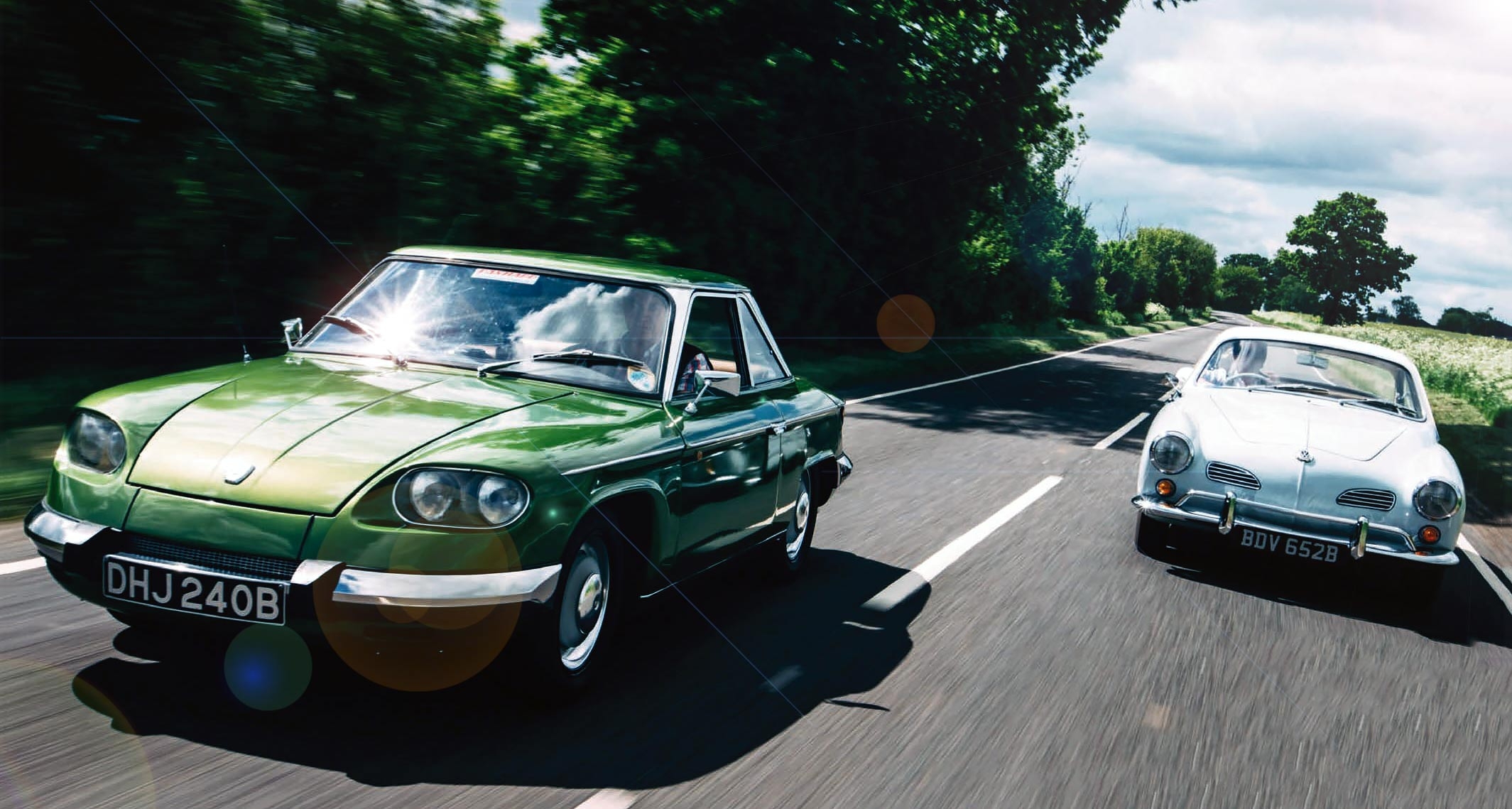
Horizontally Opposed. Air-cooled adversaries: Panhard 24CT battles Karmann Ghia. Quirky coupé shootout Panhard 24CT vs. Volkswagen Karmann Ghia. The Panhard 24CT and VW Karmann Ghia offered a quirky yet stylish alternative for image-conscious mid-’60s motorists, but which wins today? Malcolm Thorne decides Photography Malcolm Griffiths/LAT.
In the world of contemporary car design, certain ideas and formulae have been indoctrinated as ‘the right way of doing things’. Today’s compact mass-produced models almost invariably adopt a transverse, water-cooled engine driving the front wheels, so it’s a natural progression – dictated by economies of scale – that any coupé derivative will follow the same pattern.
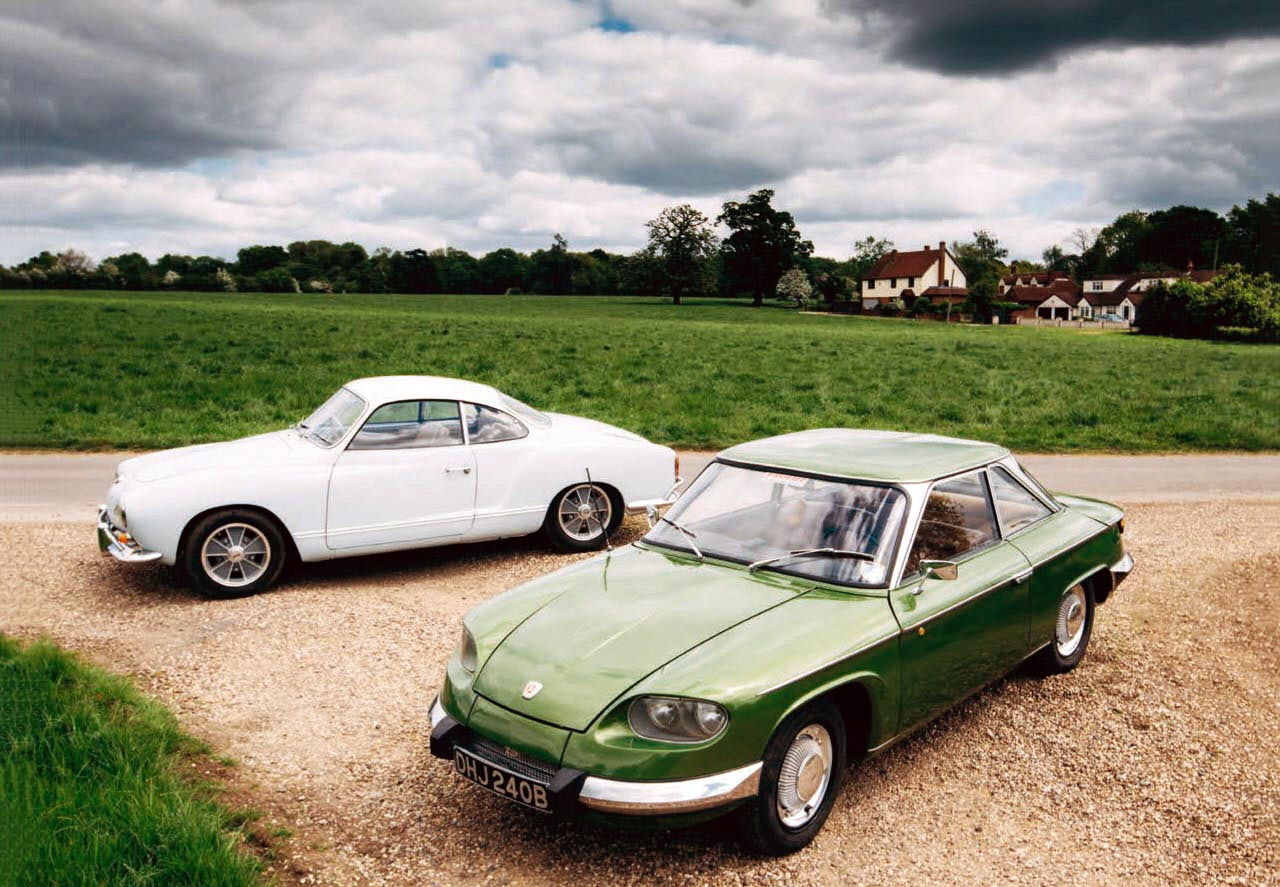
Clockwise: sharp-edged Panhard meets curvy VW; heater duct in the 24CT’s door trim and red light in the armrest; lively flattwin; oval wheel and wellstocked dash; big seats are really comfortable.
Back in the mid-’60s, though, two European firms – founding-father Panhard and relative newcomer Volkswagen – were stubbornly shunning mainstream expectations. In so doing, they produced a pair of intriguing designs that are almost obstinately different from the crowd.
There is a fascinating convergence in thinking between the two. Occupying a near-identical footprint on the road, they both embraced aircooled horizontally opposed power units and running gear from small family saloons. Performance was perhaps secondary to looks – nobody ever bought a 24CT or a Karmann Ghia to smoke the tyres – but, to paraphrase a Rolls- Royce idiom that served so well in less vulgar times, it is adequate. Yet for all the cars’ similarities, the way in which that performance is achieved – indeed, the whole ethos of the two vehicles – could hardly be more different.

Where our French contender relies on a sophisticated, highly strung 848cc flat-twin pulling at the front, its German rival employs a lazy 1192cc flat-four pushing from the back. And where one enjoyed an illustrious, 19-year career – helping its constructor on the road to global dominance – the other fizzled out after just four years, its once-proud maker starved of investment by an unsympathetic parent.
The less well known of our pairing, of course, is the Panhard. Unveiled to the press in Versailles on 24 June 1963 – fittingly, the day after that year’s Le Mans 24 Hours – the car’s name paid homage to a string of class wins at La Sarthe. It was the swansong of a long line of models from one of the oldest motor manufacturers. The final car to wear the Panhard et Levassor name, it is an endearingly enigmatic machine that today only the keenest of enthusiasts will recognise.
Its origins can be traced back to a flat-twin, front-drive economy concept of the early 1940s. Known as VP (or Voiture Populaire), the design would morph into the 610cc, aluminium-bodied Dyna X of 1947, which in turn would give way to the bulbous Dyna Z of 1954 and the similarly styled but steel-bodied PL17 of 1959.
Sharing the PL17’s mechanicals, the 24 series was conceived to fill a niche in an increasingly prosperous market and – of equal importance – to avoid any overlap with owner Citroën’s range.
The Double Chevron had acquired a 25% stake in Panhard in 1955, which increased to 100% by ’1965. The new model was offered as a long-wheelbase Berline or a short-wheelbase Coupé, with the standard 50bhp engine or the high-performance 60bhp Tigre unit. Panhard was restricted to using existing running gear to contain costs and the result was an appealing small car that is wonderfully and determinedly weird in a way that only the French could ever countenance.
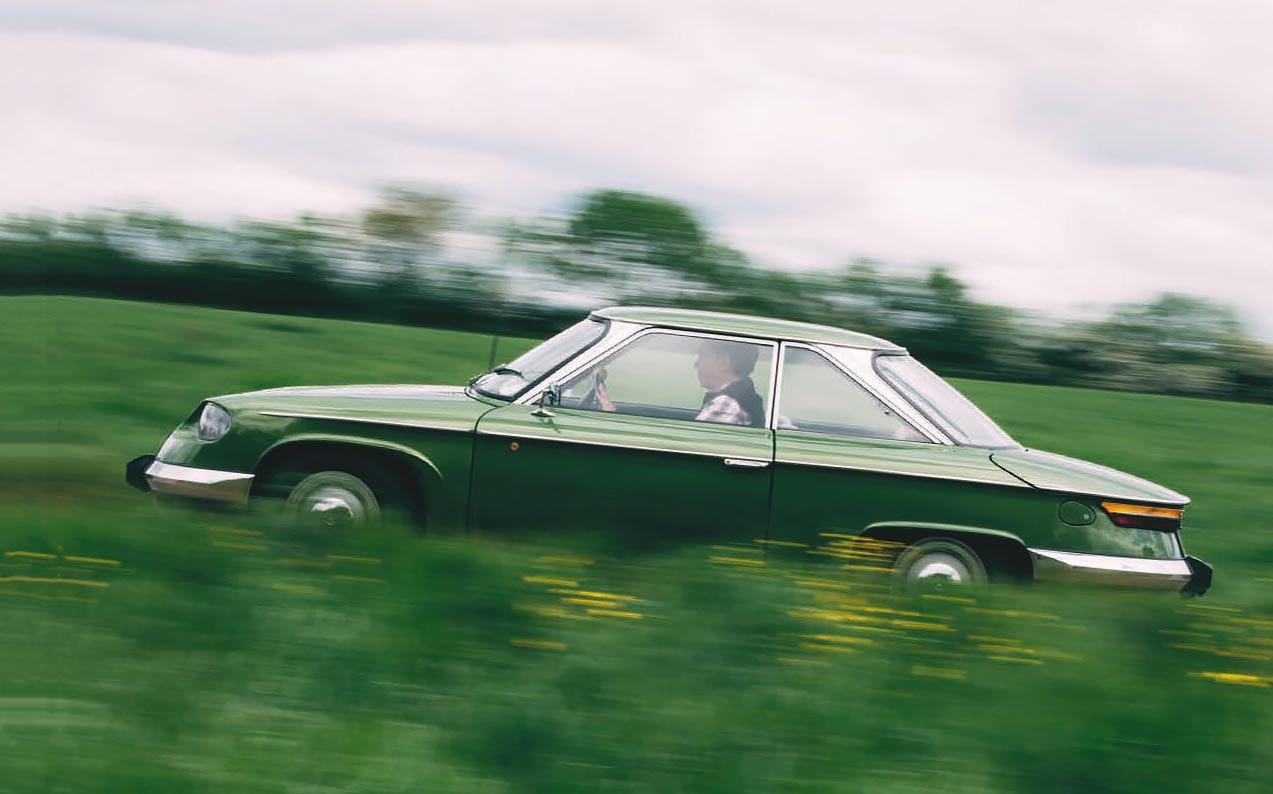
Clockwise: slim pillars ensure superb visibility in 24CT; wraparound lights are a modern touch; superrare early wheel showing finned drum looks superb but brakes were uprated to all-round discs from ’1965.
If you take outlandish to mean ‘Looking or sounding bizarre or unfamiliar’, I can think of few more fitting adjectives to describe this extraordinary vehicle. You like to embrace the unusual and stand out from the crowd? You lean towards the eccentric? This is the car for you.
Nothing rejects the mainstream with such uncompromised zeal: a Citroën DS is mere titivation compared to this hard-core device.
Cast your eyes over the slippery Louis Bionier- penned skin. From the covered headlamps – they pre-date the lookalike units that would adorn the DS from ’1967 – to the outboard finned aluminium brake drums that double as the wheel centres, the avant garde shape represents the mid-century school of futuristic at its very best. There’s logic to that design, though. The finned drums aid cooling while reducing unsprung mass. Then there’s the bizarre clap-hands wipers that flap across the screen in a seemingly random yet truly hypnotic dance. This beguiling, diminutive machine turns heads wherever it goes.
The Volkswagen, too, draws attention but for rather different reasons. Put simply, it is an achingly pretty thing. As instantly familiar as the Panhard is mysteriously alien, the Type 14 Karmann Ghia took the platform and running gear of the Beetle and mated that car’s proven durability to a seamlessly beautiful body.

The idea of producing a sleek new model on The VW base was a long-held dream of German coachbuilder (and father of the Beetle cabriolet) Wilhelm Karmann, although it materialised only when his son and namesake approached Italian carrozzeria Ghia to produce a prototype. Depending on who you ask, the car was styled by Mario Boano or Virgil Exner, but whoever was responsible for this amalgam of delectable curves, it seduces with an effortless ability.
Unsurprisingly, when Volkswagen managing director Heinz Nordhoff was shown the finished prototype, he readily agreed to put the model into production. Wolfsburg would provide the rolling chassis, Karmann would build the bodies at its factory in Osnabrück, and VW dealers would sell the finished product.
Unveiled at the Kasino Hotel in Westfalen on 14 July 1955, the Karmann Ghia rapidly became a strong seller and was produced to the tune of 444,300 examples between 1955 and ’1974, with a convertible version offered from 1957. By way of comparison, a meagre 28,651 Panhard 24s left the Paris factory between 1963 and 1967.
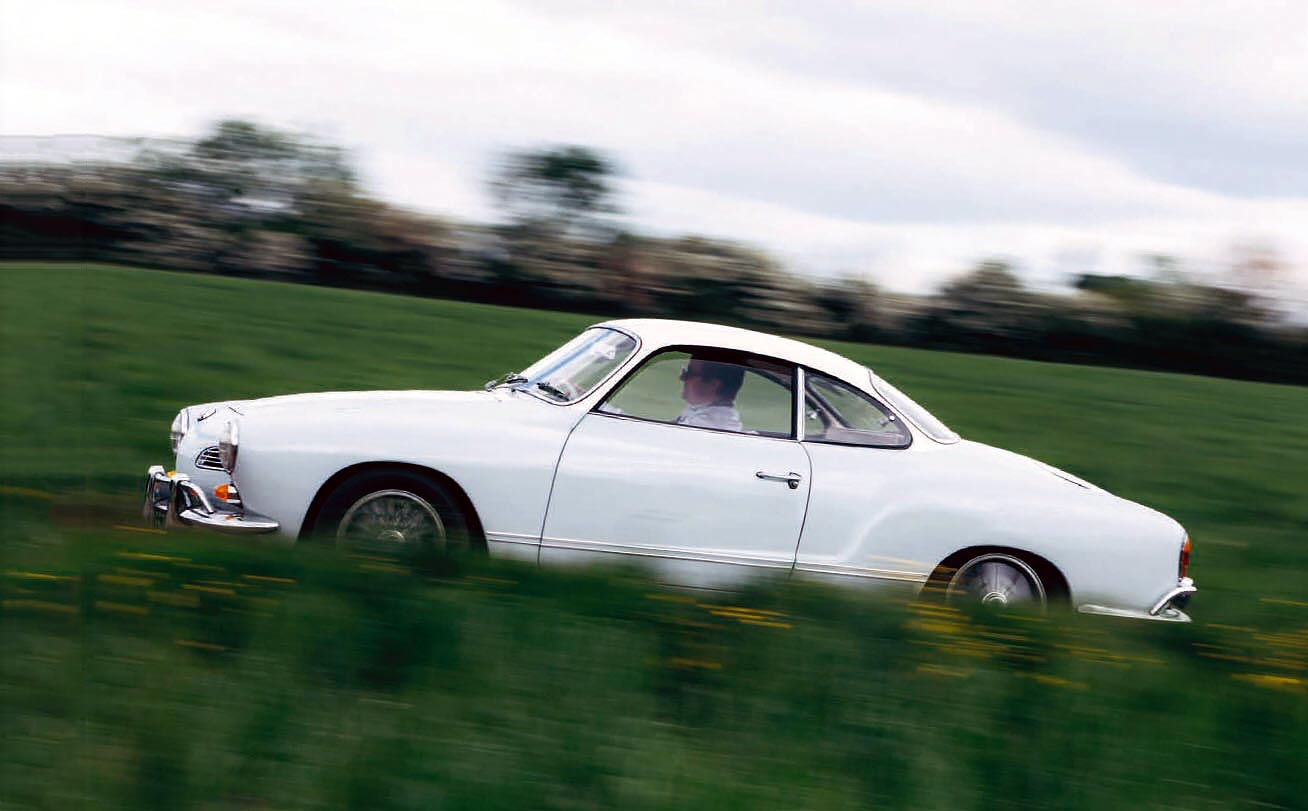
Clockwise: gorgeous profile with minimal brightwork, but sloping roof means less headroom for rear passengers; floorhinged pedals are pure Beetle – as is the familiar clunk when changing gear.
To anyone who has ever piloted a Beetle, the interior of the Karmann Ghia will be a familiar environment. The subtly wider platform places the seats further outboard compared to the Wolfsburg saloon, making the floor-hinged pedals feel even more offset than in the bug, but the cockpit is otherwise similar. It’s comfortable and inviting and, to its credit, you soon forget your contorted lower limbs.
The simple, body-coloured metal fascia provides the driver with a few odd knobs and switches, plus minimal instrumentation. It features a large, chrome-rimmed VDO speedometer and clock sandwiching a smaller fuel gauge, and that’s it. There is a refreshing austerity to the design, and certainly no pretence of it being a sports car, which is fine by me. This is a Beetle in a party frock, after all, not a cut-price Porsche, so you won’t find anything as superfluous as a rev counter or an oil-pressure gauge. What you do get is understated and beautifully crafted. From the vast white Bakelite wheel – typical of West German designs of this era – to the frameless windows and delicate winders, it’s a pleasant and evocative place to be, although the architecture and furnishings unsurprisingly feel rather more 1950s than ’60s.
Climb down into the low-slung cabin of the Panhard and, beginning with the big squashy chairs, the ambience is that of a sporting coupé. The matt-black fascia boasts a broad range of Jaeger dials, the large hooded speedo and rev counter (calibrated to a heady 8500rpm) flanked by a fuel gauge to the left and ammeter to the right, with a clock taking centre stage.
In the inimitable French fashion, the switchgear – far more of it than there is in the VW – is scattered haphazardly across the dash. A seemingly random array of unlabelled rockers plus a pair of oddly angled stalks control most functions, while a couple of additional knobs lurk beneath the thin-rimmed oval wheel to add to the confusion. It pays scant regard to ergonomics, but the fascia lends the Panhard the feel of a glamorous GT. Lovely details abound, from the clever rotary dial that controls heating (ducts running through the doors channel warm air to the rear screen for demisting), to the red warning lights integrated into the trailing edge of the armrests. The 24CT feels upmarket and sophisticated. Until, that is, you fire up the engine.

Clockwise, from above: 30bhp 1192cc ‘four’ may lack poke but it feels utterly unburstable and has better low-down torque than the Panhard; period-style BRM alloys on ‘our’ car; rear lights evolved over the years, with this type used from 1959-’1969; simple fascia with only three gauges.
Such a novel, wind-cheating shape looks as if it should house a gurgling, rasping twin-cam ‘four’ or even a silky little ‘six’, so when the feisty Louis Delagarde-designed flat-twin clatters into life, it comes as a rude shock. With its lightweight alloy construction, roller-bearing crankshaft and non-detachable hemispherical heads housing valves operated by tiny torsion bars, the Panhard’s engine was born of the most noble engineering, but it is no paragon of refinement at tickover.
Alongside the French motor, the Volkswagen’s flat-four appears a bit lacklustre with little to commend it to scholars of alternative thinking, but the lightly stressed unit feels unburstable. It also wins hands down at low revs.
Plant your right foot in the Panhard and your initial impression will be one of disappointment. At first it feels uninspiring and underpowered, barely more than an agricultural anomaly and certainly not the gem that you were expecting. Don’t despair, though. Wind the eager flat-twin towards 5000rpm and the 24CT reveals its true colours. Sounding like a 2CV on steroids, it picks up its skirts and will barrel along with remarkable and deceptively rapid pace.
The Karmann Ghia, in comparison, is far more laid-back in its power delivery and performance. Where the French machine chatters (1500rpm), growls (3000rpm) then whines like a turbine (5000rpm), the German is noticeably quieter, leaving the characteristic rasp of the flat-four in its wake. The fussy, frantic Panhard begs for revs, but the stolid, no-nonsense Volkswagen encourages a leisurely approach, relying on its greater capacity and torque to push you along.
The result is more relaxed, less manic. In the 24CT, you have to keep the crank spinning, stirring the car along with the gearbox. The Karmann Ghia demands far fewer changes – each one is accompanied by a distinctive clunk-clonk that Beetle owners will instantly recognise – and feels as though it will take you to the end of the earth and back again, but it lacks the Panhard’s urgency.
In period, the 24CT was praised for its chuckability. You could apparently step the tail out at will and let it drift (the inner rear wheel invariable a couple of inches off the ground), bringing it back under control just as easily. That’s not something you would be inclined to try in the rear-engined VW, but Autocar’s testers actually found that it was eminently controllable, and far from the wayward tail-snapper that you might expect. In any case, at the sort of speeds most classic owners will stick to, both cars feel utterly benign in their manners. The German car does offer lighter steering, though, the wheel of the front-drive Panhard weighting up noticeably through bends, while the Volkswagen also provides far superior braking. The Panhard’s finned drums look lovely, but they were regularly criticised in period road-test reports and gave way in ’1965 to an improved four-wheel disc set-up.
After spending a day with these delightfully offbeat designs, I’m torn between the two. As a practical proposition, the Karmann Ghia wins hands down and so its commercial success is more than justified. It’s not particularly quick, although it’s a delightful thing and is bestowed with genuine beauty. It really is gorgeous and I could never tire of its voluptuous curves.
But it’s a travesty – if not a surprise – that so few Panhards found buyers. It was an expensive oddity in the UK – thanks to import duty, in 1964 it cost £200 more than a Big Healey! – but, with greater investment from Citroën, it could surely have achieved greatness.
What we are witnessing here is the handing over of the baton from one generation to the next: the death throes of the world’s first series motor manufacturer, alongside the eager newcomer that was carefully eyeing up the global market. Which car would I take home? In a sense, they complement each other rather well.
The Panhard is perfect for flashing along routes nationales, where full advantage can be made of its admirably high cruising speed. But when the traffic builds up, give me the more user-friendly Volkswagen. With its greater flexibility and lighter steering, it would make far more sense to city dwellers than the peaky Panhard, which would struggle to maintain its dignity. Ultimately, though, I dearly want both.
Thanks to John Passfield, Panhard et Levassor Club GB; Joseph Denne, Karmann Ghia OC
‘IT’S PERFECT FOR ROUTES NATIONALES, TAKING ADVANTAGE OF ITS ADMIRABLE CRUISING SPEED’
John Passfield
“I was working as a milkman and spotted it in a customer’s garage,” says Passfield who has owned his 24CT for 30 years, having fallen for the model after seeing one at a Citroën event. “I asked him several times if he would sell the car but the answer was always no until, in ’1981, he emigrated to Portugal. I love its shape, comfort and individuality. Plus, it attracts a lot of attention: we were once stopped by the police so that they could ask what it was.
I’ve done a fair bit to it over the years and, in 2014, a friend, Pete Baxter, helped me to fix some rust and resprayed it. The colour is a Chrysler one called Grasshopper Green, and I get lots of comments on how much it suits the Panhard. I’m proud to own a car that is so different and that was the last of the line from an innovative maker. In the ’80s, I also ran a PL17 as an everyday car and have had a 2CV4 and an Isetta, but would never sell the 24CT.”
‘THE KARMANN GHIA’S LIGHTLY STRESSED FLAT-FOUR WINS HANDS DOWN AT LOW REVS’
Joseph Denne
“The Ghia had been a favourite of mine for many years,” says Denne, CEO of a London-based technology firm. “It was the aesthetics that I fell in love with. It took me several years to find a car meeting my criteria – 1962-’1969, RHD, rust-free and as original as possible – but the wait was worth it. I found her in Guernsey in 2014, in one of the largest and most diverse collections I’ve ever seen. I’ve had the engine out to be cleaned, but she is otherwise exactly as found. Soon after buying her we drove to Wales, which took in every type of road and some stunning scenery. It was the only time she’s been out in the wet, albeit unexpectedly, when we were caught in a snowstorm! We’ve since been as far as Cornwall in the south and Argyll in the north. The Ghia is the most comfortable car I’ve ever been in and driving it is totally relaxing. It forces a more considered pace, taking you out of the day-to-day rush.”
TECHNICAL DATA PANHARD 24CT
Sold/number built 1964-’1967/28,651 (all)
Construction tubular steel chassis, steel body
Engine all-alloy, air-cooled ohv 848cc flat-twin
Max power 60bhp @ 5800rpm
Max torque 54lb ft @ 2600rpm
Transmission four-speed manual, FWD
Suspension: front independent transverse leaf springs rear dead axle, torsion bars, Panhard rod; telescopic dampers f/r
Steering rack and pinion
Brakes drums all round (discs from ’1965)
Length 14ft ¼ in (4273mm)
Width 5ft 3 ¾ in (1619mm)
Height 4ft 1 ¼ in (1245mm)
Weight 1819lb (825kg)
0-60mph 23.9 secs
Top speed 90mph
Mpg 45
Price new £1329 (1964) Now £7-12,000+
DECHNICAL DATA VW KARMANN GHIA
Sold/number built 1955-’1974/444,300 (all Type 14s)
Construction steel platform chassis, separate steel body
Engine alloy-crankcase/head, iron-barrel, air-cooled ohv 1192cc flat-four
Max power 30bhp @ 3700rpm
Max torque 56lb ft @ 2000rpm
Transmission four-speed manual, RWD
Suspension transverse torsion bars, parallel trailing arms, telescopics; front anti-roll bar
Steering worm and roller
Brakes drums all round
Length 13ft 7in (4140mm)
Width 5ft 4in (1630mm)
Height 4ft 4in (1325mm)
Weight 1782lb (810kg)
0-60mph 28.8 secs
Top speed 73mph
Mpg 35
Price new £1010 (1964) Now £8-25,000+
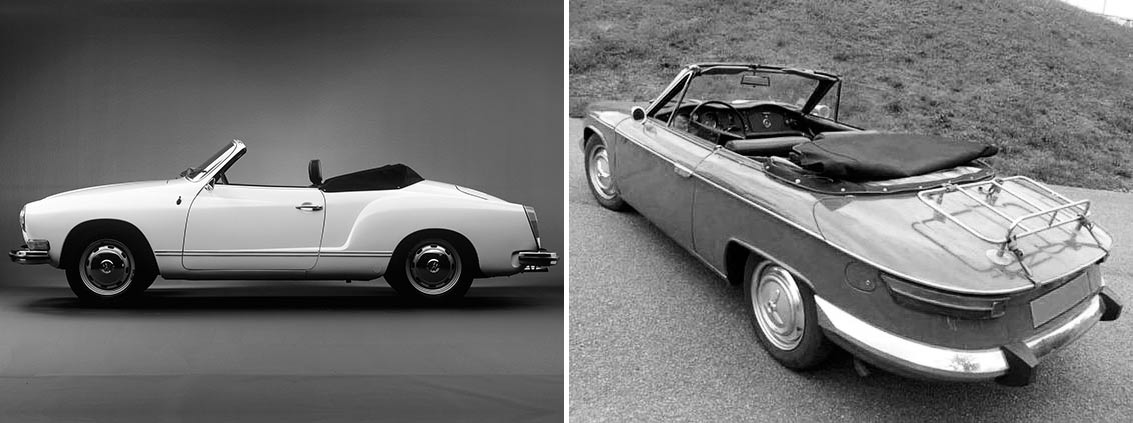
Right: Karmann Ghia also came as a chic cabriolet. A soft-top was proposed for the 24CT (below), which was launched in Versailles.
{CONTENTPOLL [“id”: 69]}





